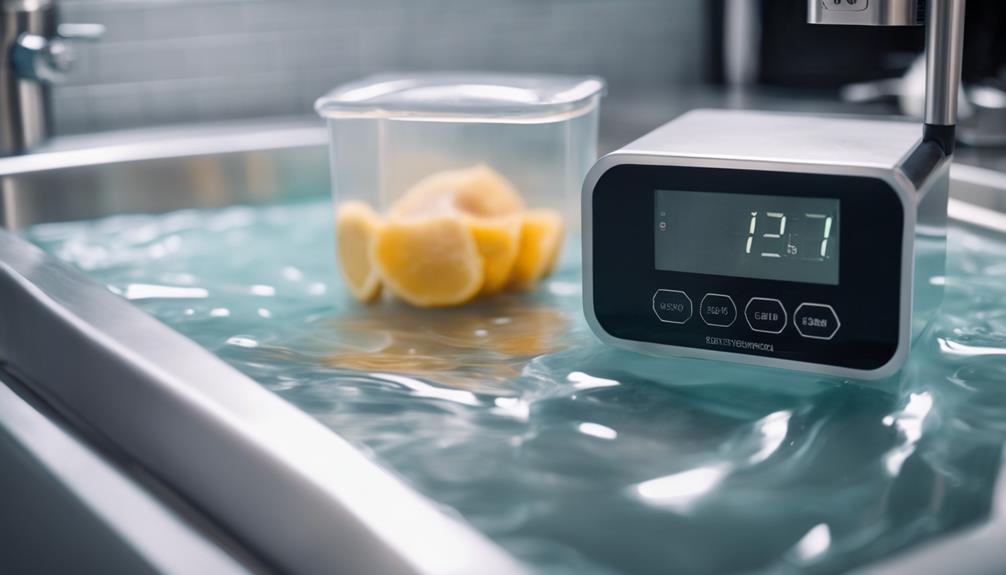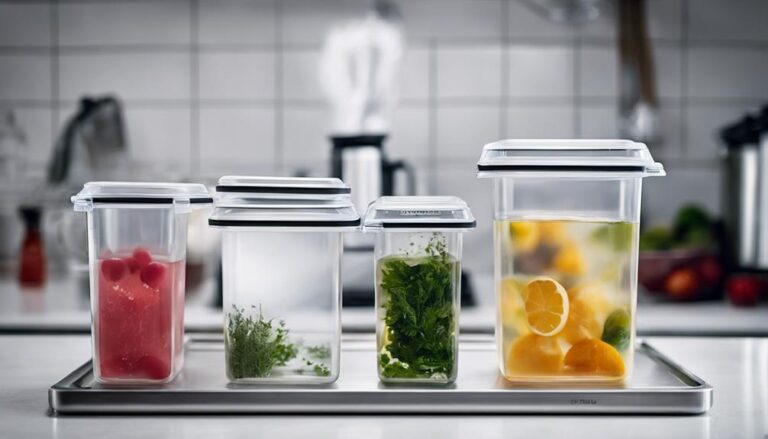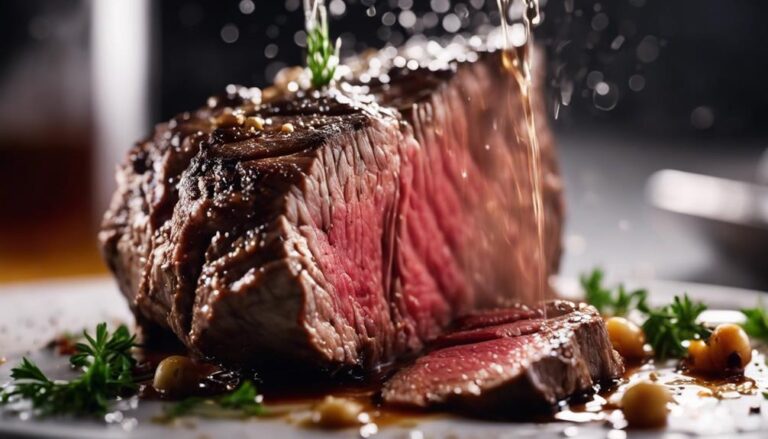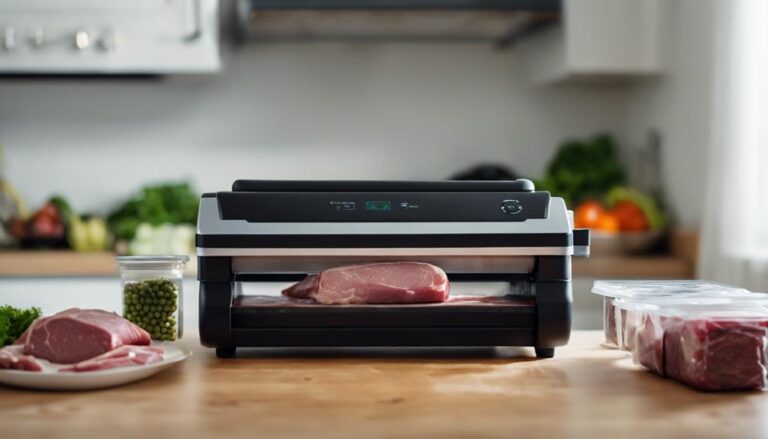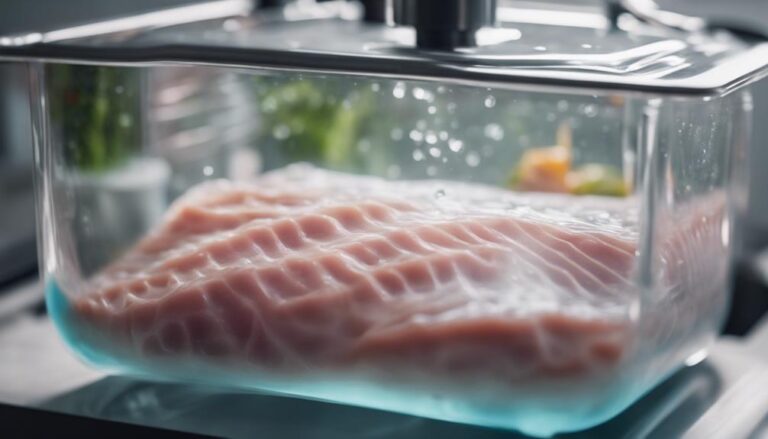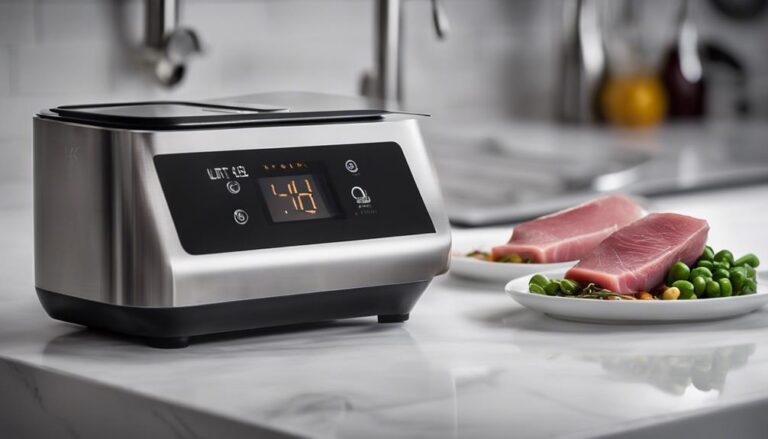Maintaining Temperature Accuracy: Tips for an Even Sous Vide Cook
Achieve perfect sous vide dishes by focusing on maintaining temperature accuracy. Calibrate your equipment for precise control. Position your water bath strategically for even heat distribution. Use insulation techniques to retain heat effectively. Monitor water circulation regularly for consistent results. Verify vacuum seals are secure to prevent water infiltration. Choose the right container size for ideal cooking conditions. Adjust cooking times and temperatures as needed for perfect results. Finish off with searing and creative presentation for an extra touch. Master these tips for a flawless sous vide cook!
What You Will Learn Here
- Calibrate equipment for precise temperature control.
- Use insulation techniques to maintain accurate temperatures.
- Monitor water circulation for consistent cooking results.
- Secure vacuum seals properly to prevent water infiltration.
- Adjust cooking times and temperatures for perfect doneness.
Importance of Temperature Accuracy
Maintaining precise temperature control is essential for successful sous vide cooking. In sous vide, temperature consistency is key to achieving the desired level of doneness in your dishes. This precision cooking technique relies heavily on upholding a constant temperature to guarantee that your food cooks evenly from edge to edge. To achieve this level of precision, you must have equipment reliability. Your sous vide machine must be able to consistently uphold the set temperature throughout the entire cooking process. Any fluctuations in temperature can result in over or undercooked food, compromising the quality of your dish.
Temperature control isn't just about setting the right temperature; it's about ensuring that temperature is upheld accurately. Investing in a high-quality sous vide machine will provide you with the necessary tools to achieve precise temperature control. By carefully monitoring and adjusting the temperature settings, you can create restaurant-quality dishes from the comfort of your own kitchen. Remember, in precision cooking like sous vide, temperature accuracy is key to culinary success.
Calibrating Sous Vide Equipment
To guarantee precise temperature control in sous vide cooking, calibrating your equipment is vital. Equipment calibration methods are essential for making sure that your temperature probe accuracy and precision are spot on. If you notice any inconsistencies or deviations in temperature readings, troubleshooting may be necessary.
One method to calibrate your equipment is by using a precision thermometer to check the precision of your sous vide machine's temperature probe.
To calibrate, fill a container with water, set your sous vide device to a specific temperature, and compare the actual water temperature with the displayed temperature. If there's a difference, you may need to adjust the settings or consider recalibrating the equipment. Remember, even minor disparities can impact the outcome of your sous vide dishes.
Water Bath Placement Tips
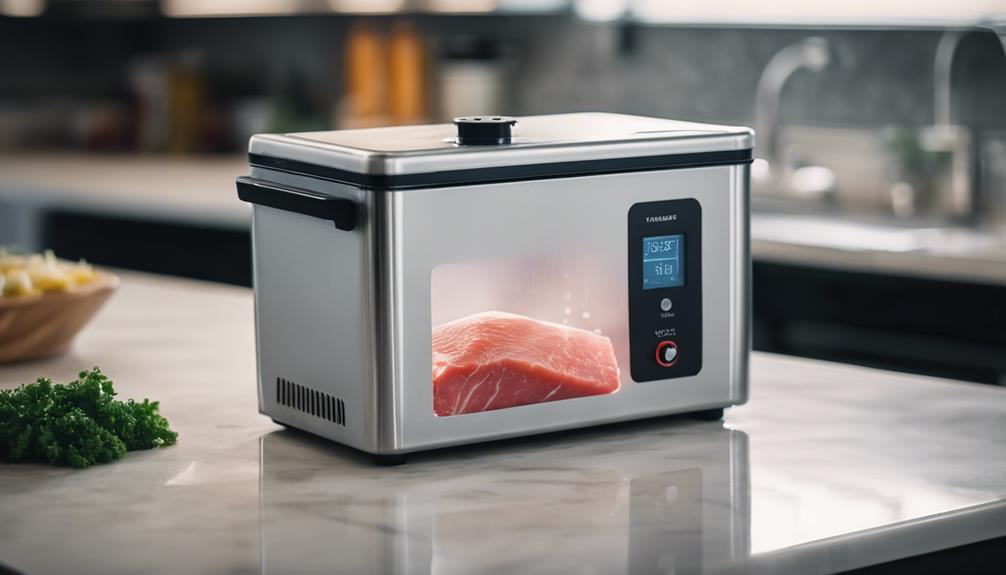
When setting up your sous vide water bath, remember to guarantee proper water circulation by placing your sous vide device in an area with unhindered flow.
Additionally, be mindful of avoiding heat loss by situating your water bath away from drafts or cold surfaces.
Proper Water Circulation
For ideal water circulation in sous vide cooking, consider positioning your water bath strategically to guarantee uniform heat distribution. By placing the water bath in an area where there's good air circulation and avoiding cramped spaces, you can enhance circulation efficiency and prevent cold spots.
Make sure that the water level in the bath is sufficient to cover your ingredients fully, allowing the circulator to work effectively. Additionally, positioning the water bath on a stable surface will prevent unnecessary vibrations that could disrupt the water flow.
Avoiding Heat Loss
Strategically positioning your water bath plays a crucial role in minimizing heat loss during sous vide cooking. To prevent evaporation and condensation, place your water bath in a draft-free area away from air vents or open windows. Keep the water level consistent to maintain heat retention efficiency.
Additionally, using an insulated container or covering your water bath with a lid can help trap heat and reduce energy consumption. Be mindful of the surroundings; avoid placing the water bath near cold surfaces or appliances that emit heat.
Utilizing Insulation Techniques
When maintaining temperature accuracy in sous vide cooking, you can enhance insulation by utilizing heat retention materials, employing thermal wrapping methods, and using insulated water containers.
These techniques help minimize heat loss, ensuring that your water bath stays at the precise temperature required for successful sous vide cooking.
Heat Retention Materials
Insulating your sous vide setup with proper materials is essential for maintaining temperature accuracy during cooking. When selecting heat retention materials, focus on ones that excel in heat distribution and insulation effectiveness.
Consider using materials like neoprene sleeves or foam insulation to wrap around your water container. These materials are efficient at trapping heat and preventing temperature fluctuations, ensuring a consistent cooking environment.
Thermal Wrapping Methods
Consider utilizing thermal wrapping methods to enhance insulation techniques for maintaining temperature accuracy in sous vide cooking.
Insulation effectiveness is vital to prevent heat loss during the cooking process. When selecting wrapping materials, opt for those with low thermal conductivity to minimize temperature fluctuations.
Materials like neoprene sleeves or silicone covers can provide excellent insulation properties. To improve insulation effectiveness, make sure that your sous vide cooking vessel is tightly wrapped with the chosen material.
Pay attention to wrapping techniques, such as double-layering the insulation or using reflective barriers to trap heat efficiently.
Insulated Water Container
To enhance the insulation techniques for maintaining temperature accuracy in sous vide cooking, make sure your sous vide cooking vessel is properly wrapped with an insulated water container. This step aids in efficient insulation and temperature retention, ensuring a consistent cooking environment for your ingredients.
Here are four tips to optimize the use of an insulated water container:
- Choose Quality Insulation: Use materials like neoprene or foam to wrap your cooking vessel securely.
- Cover the Lid: Insulate not just the sides but also the top of the container to minimize heat loss.
- Monitor for Gaps: Check for any openings or leaks in the insulation that could compromise temperature control.
- Preheat the Container: Warm up the container before placing your ingredients to help maintain the desired temperature more effectively.
Monitoring Water Circulation
Monitoring water circulation guarantees proper distribution of heat in your sous vide cooking setup, promoting consistent cooking results. Efficient water flow monitoring is essential to maintain precise temperatures throughout the cooking process. Make sure to check the circulation patterns in your water container regularly to confirm that heat is evenly dispersed around your food. Troubleshooting any circulation issues promptly can prevent temperature fluctuations that may impact the doneness of your ingredients.
To optimize water circulation, position your sous vide machine strategically within the water container. Placing it in a central location helps to circulate the water more effectively around the food pouches. Additionally, avoiding overcrowding in the container allows for better flow patterns, resulting in more uniform cooking. If you notice any areas where the water seems stagnant or cooler, gently agitating the water or repositioning the pouches can help redistribute the heat evenly.
Securing Vacuum Seals Properly
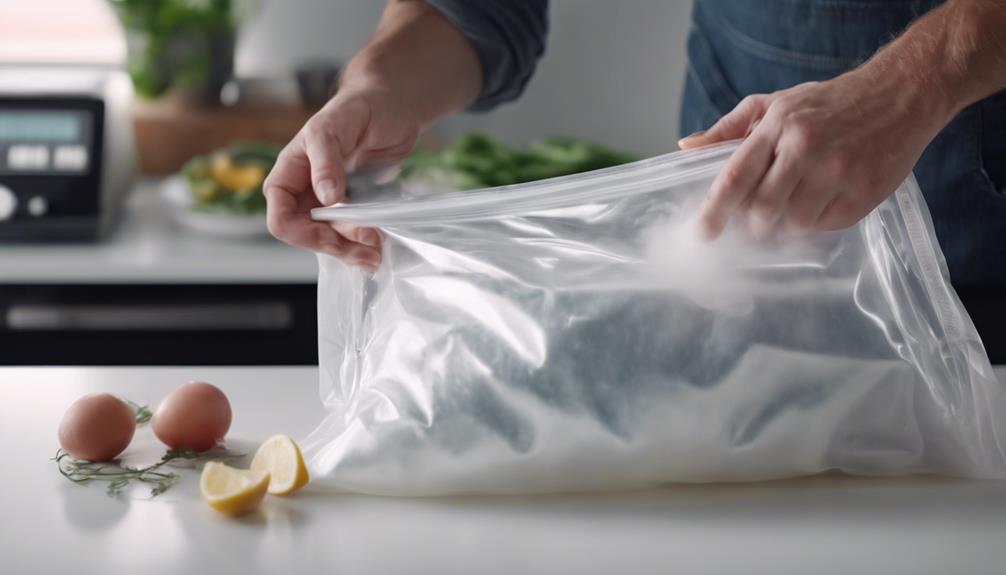
Securing vacuum seals correctly guarantees airtight packaging for your ingredients during sous vide cooking, preventing water infiltration and maintaining ideal cooking conditions. To make sure your vacuum seals are properly secured, follow these essential tips:
- Vacuum Sealer Techniques: Master the correct use of your vacuum sealer by carefully reading the manufacturer's instructions. Each model may have specific techniques for best sealing.
- Seal Inspection: Before starting the cooking process, examine the seals of your bags thoroughly. Look for any signs of leaks or improper sealing that could compromise the cooking process.
- Bag Sealing Troubleshooting: If you encounter sealing issues, such as wrinkles or folds preventing a tight seal, reseal the bag using the troubleshooting techniques provided by your vacuum sealer's manual.
- Air Removal Strategies: Utilize effective air removal strategies to make sure that there's minimal air left in the bag before sealing. Proper air removal is key to achieving a tight vacuum seal for successful sous vide cooking.
Choosing the Right Container Size
Selecting the appropriate container size plays an essential role in ensuring efficient and consistent sous vide cooking results. When choosing a container for your sous vide cooking, consider the size of the food items you'll be cooking. The container should be large enough to comfortably hold the food pouches without overcrowding, allowing water to circulate freely around them. This promotes even cooking and guarantees that all food is cooked to the desired level of doneness.
Container selection is critical for maintaining temperature accuracy during the sous vide cooking process. Opt for containers that are well-insulated to help retain heat effectively. Insulation methods like using a lid or covering the container with a towel can further aid in temperature control. This helps prevent heat loss and fluctuations, resulting in more precise cooking outcomes.
Adjusting Cooking Times and Temperatures
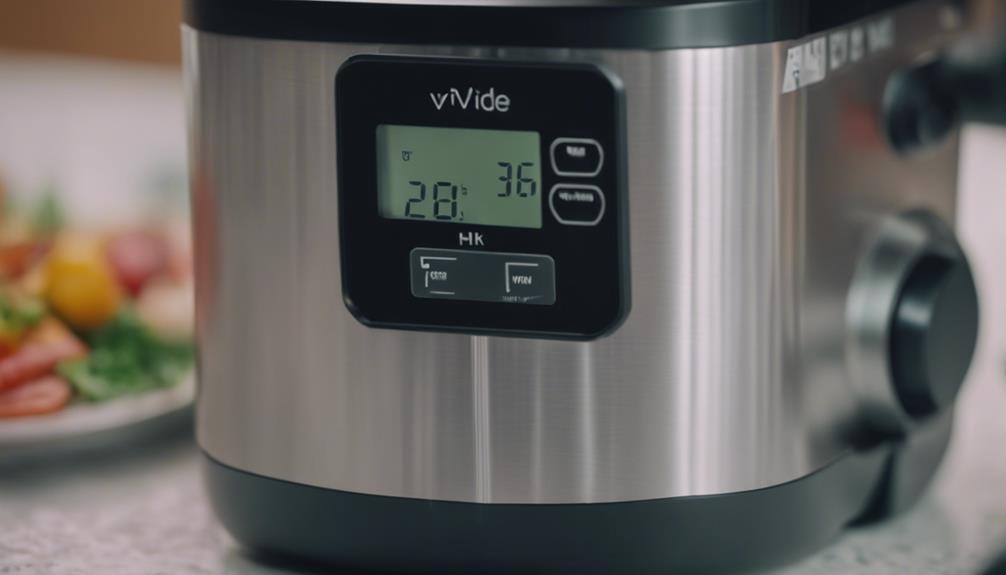
When guaranteeing your sous vide cooking success, fine-tuning cooking times and temperatures is crucial for achieving the best results. Making precise adjustments can elevate your culinary creations. Here are some tips to help you master the art of adjusting cooking times and temperatures:
- Sous Vide Tweaks: Experiment with different sous vide settings to find the perfect balance for your desired doneness. Small tweaks can make a significant difference in the outcome of your dish.
- Timing Tweaks: Keep track of the cooking times for different cuts of meat or types of vegetables. Adjusting the timing based on the specific item being cooked ensures the most favorable results every time.
- Temperature Control: Be vigilant about monitoring the water temperature throughout the cooking process. Minor fluctuations can impact the final texture of your food, so make adjustments as needed.
- Cooking Adjustments: Don't be afraid to make on-the-fly adjustments if you notice the food isn't progressing as expected. Trust your instincts and make the necessary changes to achieve the perfect sous vide cook.
Finishing Techniques for Perfect Results
To achieve ideal results in sous vide cooking, consider employing effective finishing techniques that enhance the overall flavor and presentation of your dishes. One popular finishing technique is the searing method, which involves quickly searing the protein in a hot pan or using a culinary torch after the sous vide cooking process. This step adds a beautiful caramelized crust to your meat or fish, enhancing both texture and flavor. Another great way to elevate your dish is by incorporating creative presentation ideas. You can garnish your plate with fresh herbs, edible flowers, or colorful sauces to make your meal visually appealing and appetizing. Below is a table summarizing some finishing techniques for perfect sous vide results:
| Finishing Technique | Description |
|---|---|
| Searing Method | Adds a caramelized crust for extra flavor |
| Presentation Ideas | Enhances visual appeal with garnishes |
Frequently Asked Questions
Can I Use Frozen Ingredients in Sous Vide Cooking, or Should Everything Be Thawed Beforehand?
You can use frozen ingredients in sous vide cooking, but it's best to thaw them first for even cooking. Sous vide cookware guarantees temperature control, so start with thawed items for consistent results.
How Can I Prevent Evaporation From Affecting the Water Level in My Sous Vide Setup During Long Cooking Sessions?
To prevent evaporation and maintain the water level during long sous vide cooking, cover your setup with a lid or plastic wrap. This simple step helps control evaporation, ensuring a consistent water level for even cooking results.
Are There Any Specific Safety Precautions I Should Take When Using Sous Vide Equipment for Extended Periods of Time?
When using sous vide equipment for extended periods, make sure equipment maintenance and safety measures. To maintain equipment durability, regularly check for wear, clean components, and follow manufacturer guidelines. Prioritize safety to enjoy worry-free cooking sessions.
Can I Leave My Sous Vide Machine Unattended While Cooking, or Should I Monitor It Constantly?
You can leave your sous vide machine unattended thanks to remote monitoring and automation features. Temperature probes and alerts guarantee you can step away without worry, allowing you to enjoy convenience while still maintaining control over your cooking process.
Are There Any Alternative Methods for Achieving the Same Level of Temperature Accuracy if I Don't Have Access to a Sous Vide Machine?
If you lack a sous vide machine, explore DIY methods like using a thermometer in a pot of water on low heat for temperature control. Precision cooking can still be achieved with these temperature alternatives, ensuring delicious results.
Conclusion
So, keep these tips in mind to make sure your sous vide cooking is always on point.
By maintaining temperature accuracy through proper calibration, placement, insulation, and monitoring, you'll be on your way to perfectly cooked dishes every time.
Don't forget to secure those vacuum seals and choose the right container size for best results.
With a little attention to detail and some adjustments when needed, you'll be a sous vide pro in no time.
Happy cooking!
